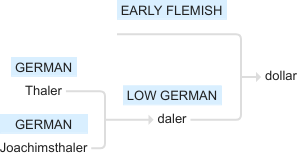Dollar
from early Flemish or Low German daler, from German T(h)aler, short for Joachimsthaler, a coin from the silver mine of Joachimsthal (‘Joachim's valley’), now Jáchymov in the Czech Republic. The term was later applied to a coin used in the Spanish American colonies, which was also widely used in the British North American colonies at the time of the American War of Independence, hence adopted as the name of the US monetary unit in the late 18th century.
wiktionary
Attested since about 1500, from early Dutch daler, daalder, from German Taler, Thaler(“dollar”), from Sankt Joachimsthaler, literally "of Joachimstal," the name for coins minted in German Sankt Joachimsthal(“St. Joachim's Valley”) (now Jáchymov, Czech Republic). Ultimately from Joachim + Tal(“valley”). Cognate to Danish daler. Doublet of taler.
etymonline
dollar (n.)
"monetary unit or standard of value in the U.S. and Canada," 1550s, daler, originally in English the name of a large, silver coin of varying value in the German states, from Low German daler, from German taler (1530s, later thaler), abbreviation of Joachimstaler, literally "(gulden) of Joachimstal," coin minted 1519 from silver from mine opened 1516 near SanktJoachimsthal, town in Erzgebirge Mountains in northwest Bohemia. German Tal is cognate with English dale. The spelling had been modified to dollar by 1600.
The thaler was from 17c. the more-or-less standardized coin of northern Germany (as opposed to the southern gulden). It also served as a currency unit in Denmark and Sweden (and later was a unit of the German monetary union of 1857-73 equal to three marks).
English colonists in America used the word dollar from 1580s in reference to Spanish peso or "piece of eight," also a large silver coin of about the same fineness as the thaler. Due to extensive trade with the Spanish Indies and the proximity of Spanish colonies along the Gulf Coast, the Spanish dollar probably was the coin most familiar in the American colonies and the closest thing to a standard in all of them.
When the Revolution came, it had the added advantage of not being British. It was used in the government's records of public debt and expenditures, and the Continental Congress in 1786 adopted dollar as a unit when it set up the modern U.S. currency system, which was based on the suggestion of Gouverneur Morris (1782) as modified by Thomas Jefferson. None were circulated until 1794.
When William M. Evarts was Secretary of State he accompanied Lord Coleridge on an excursion to Mount Vernon. Coleridge remarked that he had heard it said that Washington, standing on the lawn, could throw a dollar clear across the Potomac. Mr. Evarts explained that a dollar would go further in those days than now. [Walsh]
Phrase dollars to doughnuts "an assured thing, a certainty" (such that one would bet a dollar against a doughnut on it) is attested by 1884; dollar diplomacy "financial imperialism, foreign policy based on financial and commercial interests" is from 1910.
The dollar sign ($) is said to derive from the image of the Pillars of Hercules, stamped with a scroll, on the Spanish piece of eight. However, according to the Bureau of Engraving and Printing of the U.S. Department of the Treasury:
[T]he most widely accepted explanation is that the symbol is the result of evolution, independently in different places, of the Mexican or Spanish "P's" for pesos, or piastres, or pieces of eight. The theory, derived from a study of old manuscripts, is that the "S" gradually came to be written over the "P," developing a close equivalent of the "$" mark. It was widely used before the adoption of the United States dollar in 1785.
